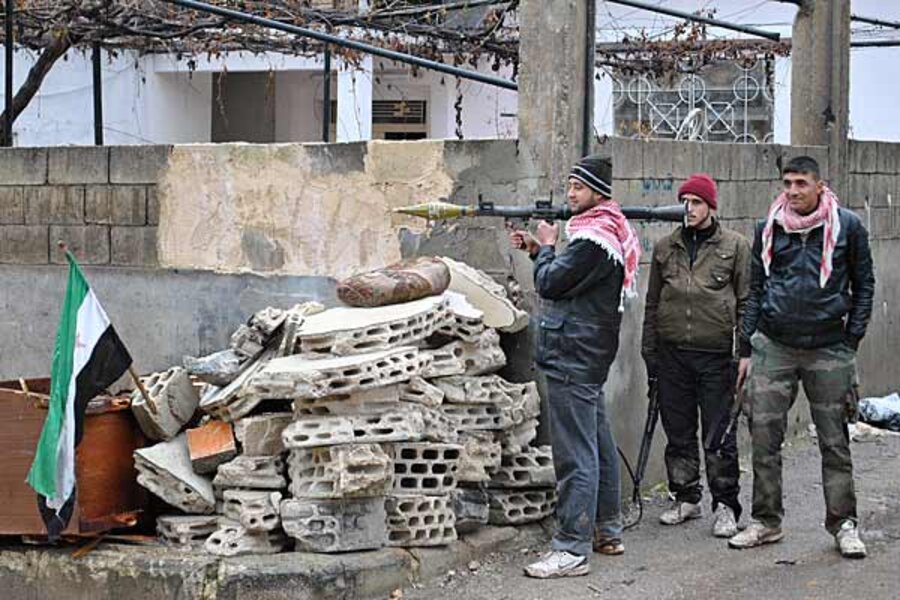Graphic images flood out of Syria. Why no world uproar?
Loading...
A long, tense public session in the UN Security Council yesterday on a resolution calling for Syrian President Bashar al-Assad to step down and allow a transitional government to be formed can be summed up with one word: "Nyet."
That appeared to be the position of veto-wielding UNSC member Russia. The NATO intervention in Libya, which tipped the scales of that country's rebellion against Muammar Qaddafi, infuriated Russia, which says it's taking a hard line now to prevent a repeat.
Following Syria's war from abroad can lead to a day filled with horrors. Social media networks are filled with daily footage of the carnage uploaded by amateur cameramen and pictures of the dead and dying – men, women, and children all. But the excitement of 2011 about the Arab uprisings internationally has started to wane. At the start of last year, it seemed the whole region could be transformed with nary a shot being fired. Now that optimism has been replaced with an almost numbing wash of pictures and videos that, due to their very ubiquity, are losing their power to mobilize international action.
Years ago, when I went to work for the Far Eastern Economic Review, my boss John McBeth summed up successful magazine writing in two words. "Think pictures," he told me then. And he was right. If a story could be built around arresting images, it always had much more impact.
In the late 1990s, I covered the end of Indonesia's long occupation in East Timor. Many of the Timorese activists and rebel fighters who had opposed Indonesia's invasion of East Timor in 1975 and annexation of the former Portuguese colony were convinced that a single piece of footage had tipped the international scales in their favor. In 1991, a British journalist going by the name Max Stahl (his real name is Christopher Wenner) had sneaked into the territory and was filming a protest march at Santa Cruz cemetery in Dili when a confrontation with Indonesian soldiers devolved into a massacre.
Dozens were killed, and when the footage was slipped out of the country and ended up being run on broadcasts around the world, it inspired an international solidarity campaign for East Timor that put pressure on Indonesian allies likes Australia and the US. In 1996, East Timor's main international advocate José Ramos-Horta (currently the tiny country's president) and Dili-based Bishop Carlos Belo were awarded the Nobel Prize, upping their own profiles and the ante against Indonesia.
When Indonesia's dictator Suharto fell in 1998, a large segment of Indonesia's establishment had tired of constant international opprobrium over Timor. The country's longstanding foreign minister Ali Alatas called Timor "the pebble in our shoe" and an exhausted Indonesia allowed Timor to go via a UN-sponsored independence referendum, albeit with a punishing scorched earth coda as Indonesian troops withdrew.
When the rare becomes commonplace
That was the power of images then, not so very long ago. But what had been a rare journalistic feat is now commonplace. Anyone with an Internet connection can fill their days looking at footage of protests, shootings, and their aftermath. But their ubiquity has drained images of some of their power.
To be sure, it isn't entirely clear what comes next. The Syrian regime isn't giving up, and its opponents don't appear to be willing to give in. Monday was filled with fighting across Syria, and every sign is that battles raged again today. In addition to rebel strongholds like Homs and Hama, opposition has spread to the outskirts of Damascus, with the Saqba and Maleiha areas apparently in rebel control, and Assad's troops pushing to regain full control of the capital.
The draft resolution against Syria at the UN appears to be a dead letter, but its language is stronger than an earlier version that Russia and China opposed, reflecting the frustration of countries like the US with the ongoing carnage in Syria. On Monday, for instance, fierce fighting in Homs left the dead scattered across a public street.
But for now, the daily dose of war and suffering, delivered to anyone with the stomach to watch it and a Facebook or Twitter account, will continue.







